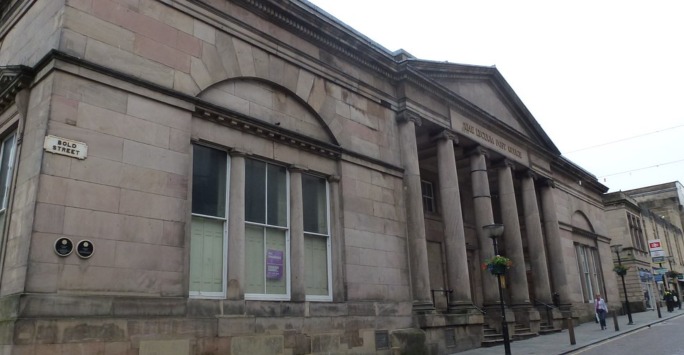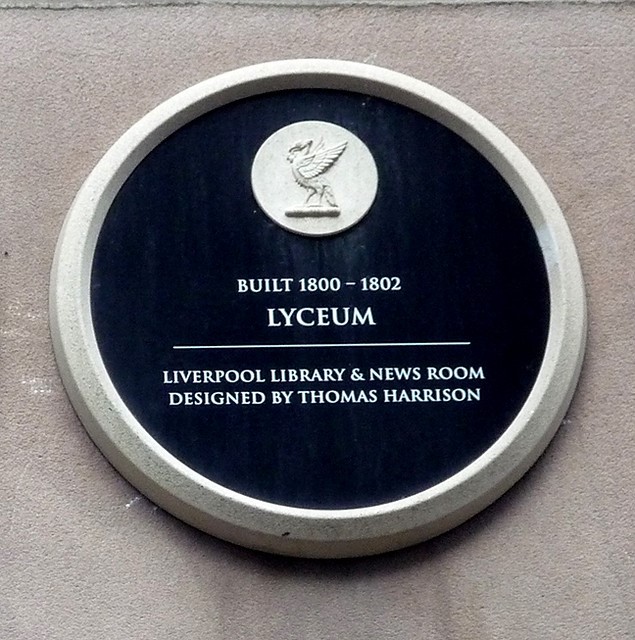Commerce and Culture: A Call to Explore the Liverpool Lyceum’s History

MA Student, Emma McCabe, explores the history of Liverpool's former cultural intuition, The Lyceum, and its significance in Liverpool's transatlantic slave trade history.
Let’s cast our minds back to Liverpool at the beginning of the nineteenth century. The population stands at 77,000 and continues to grow thanks to the commercial opportunities Liverpool has to offer. Such opportunities arise from Liverpool having secured her position at the forefront of the transatlantic slave trade – allowing the town to advance its prosperity at a speed hitherto unknown in English history. Liverpool merchants were responsible for transporting approximately 1,171,171 enslaved peoples across the Atlantic, and it’s this level of involvement that gave Liverpool an unfavourable reputation. Such commercial towns are described by Penelope Corfield as “drab, workaday places which, even by the standards of their own day, they were hardly showplaces. Polite society went to be entertained at Bath or London.”
However, this opinion undermines the cultural renaissance that Liverpool experienced as a result of the transatlantic slave trade – making commerce and culture inextricably linked to one another. Liverpool merchants funnelled money into the city’s cultural landscape, precisely to combat this perception of the town as drab and hellbent on the pursuit of trade. By becoming patrons of cultural institutions, Liverpool merchants could better assimilate into polite society and foster a cultivated image of themselves and the town more generally.
Today, many of these cultural institutions still exist and – given the resurgence in Black History propelled by the 2020 Black Lives Matter movement – are beginning to uncover their ties to the transatlantic slave trade. For instance, Lucy Moynihan, a student at the University of Liverpool, has partnered with the Atheneum to discover the institutions connection to slavery and abolition. Similarly, The Bluecoat – the oldest surviving building in central Liverpool and home to the city’s contemporary arts centre – has recently began to research into its origins as a charity school and its connections to Bryan Blundell and other slave-trading merchants. More generally, Liverpool City Council has agreed to add plaques to accompany certain street names in the city that commemorate slave traders – such as Tarleton Street, Seel Street, and Parr Street.
The Lyceum is another former cultural institution that is yet to have its history explored. Today, the Lyceum stands bordered up, empty, and void of any notable historical significance. The neo-classical structure has housed everything from a post office, restaurant, and bar in the past three decades and is now set to become a Jungle Rumble miniature golf course with further planning approval. Yet with the increasingly novel use of the Lyceum building, it becomes ever more important to ensure its foundational roots and links to the transatlantic slave trade are not overwritten or ignored.
Built in 1802 by famed architect Thomas Harrison, the Liverpool Lyceum was the first subscription library to exist in Britain. The journey to its foundation really begins in 1755 with a few gentlemen who had “been in the habit of meeting together for the purpose of discussing literary subjects, and of reading a portion of the periodical publications of the day.” The gentlemen would meet in the home of William Everard, a Liverpool school master, and later decided to formalise their operations by creating a subscription library where they could circulate topical books. The library was first located in a new building on Lord Street before being moved to the Liverpool Lyceum in Bold Street.

When taking a closer look into the Lyceum’s history, the link between commerce and culture becomes abundantly clear. Currently, the only documented link between the Lyceum and the transatlantic slave trade is established through Thomas Staniforth – the banking partner and slave trader who occupied the land the Lyceum is built upon. However, the Lyceum patrons list shows that some of Liverpool’s most prominent merchants were members of the library too. As a subscription-based library, the successful operation of the institution depended on the fifteen shillings members paid annually. Among these members were those who received their income from trading in enslaved Africans, such as John Lightbody. Lightbody was a merchant who was involved in at least 14 voyages that transported enslaved Africans across the Atlantic. According to the Slave Voyages Database, Lightbody was responsible for the transportation of approximately 3,797 enslaved people – usually to the British Caribbean. William Goodwin, who was the Mayor of Liverpool in 1757, was also involved in 10 slave voyages between 1749 and 1756. Many of those enslaved on Goodwin’s vessels were captured in Bonny; one of the main entry posts on the Slave Coast. Lightbody and Goodwin are just two examples that represent the Lyceum’s ties to transatlantic slavery. It is the affluence and status of these men, stemming from their participation in the trade, that would have allowed them to subscribe to the Lyceum.
However, Lyceum membership was not exclusive to Liverpool slave-trading merchants. William Roscoe, William Rathbone IV, Reverend John Yates, and Dr. James Currie were also among the Lyceum members and all actively campaigned against the transatlantic slave trade. If you don’t know by now, Rathbone and Roscoe are widely celebrated – arguably too much so – as the ‘fathers of abolition’ in Liverpool. William Rathbone IV was a founding member of the Liverpool Society for the Abolition of the Slave Trade while Roscoe wrote poems and pamphlets opposing the trade. Some examples of Roscoe’s work include ‘The Wrongs of Africa’ and ‘A Scriptural Refutation of a Pamphlet.’ Dr. James Currie was a Liverpool physician and early advocate for abolition, and Reverend John Yates was a Unitarian minister who received backlash from his congregation after giving abolitionist sermons in 1788. The 1793 book catalogue for the Lyceum shows that it contained 16 pamphlets both for and against abolition of the slave trade, which speaks to the inclusive nature of the Lyceum upon topical debates. Speaking on Liverpool’s ‘need’ for social inclusivity in the eighteenth century, Jon Stobart states:
“It seems likely that the need for social integration within the growing middling ranks of these towns and their desire to differentiate themselves from ordinary working people were also powerful encouragements to this development of polite culture.”
The need for social integration was essential among merchants given that a majority came from non-established backgrounds. Examples include John and Thomas Hodgson who, prior to transporting approximately 50,133 enslaved people, came from a family of yeoman farmers in Caton, Lancashire. By investing in cultural institutions that were only accessible to the upper echelons of the town, middle-class merchants were able to assimilate into high society. The Lyceum then, like many other cultural institutions at the time, provided a controlled arena for social contact among respectable classes – irrespective of political agenda – to allow for greater proliferation and networking. The Liverpool Guide confirms this need for social integration in verifying that the Lyceum was built out of rivalry with the Athenaeum, located on School Lane, which had an exclusive membership denied to even the wealthiest merchants in society.
It goes without saying that cultural attainment took precedence over commercial attainment in this respect. Economic capital would always remain important, as it guaranteed access to such institutions. Yet cultural capital was a more subtle means of demonstrating respectability. The fact that the Lyceum did not appear in a vacuum, but rather off the back of The Bluecoat, The Athenaeum, and the Royal School for the Blind, is a further testament to the wider significance of cultural institutions during the eighteenth and nineteenth century. Collectively, these institutions reflected a formalisation of knowledge whereby coffee house attendees officialised their meetups and created structures that supported their social and cultural advancement. Institutions that aimed to advance the rationale and knowledge of their members is a far cry from the brutish reputation attributed to Liverpool merchants in their pursuit of trade.
It appears that nothing is left to chance, as even the Lyceum’s location can be strategically linked to commerce and culture. Liverpool’s wider landscape is indicative of this need to overwrite the narrative of a town hellbent on the production and maintenance of trade. The centre of trade operations took place along the dock front, with what we now know as Ropewalks being the epicentre for commercial operations. However, on the outskirts of the centre, are institutions such as the Lyceum, the Liverpool School for the Blind, and The Bluecoat. Bold Street in and of itself was a fashionable location in Liverpool, home to some of the wealthiest slave-trading families such as the Tarleton’s. Such fashionable locations were noted for their image of respectability, and this is apparent in how contemporary descriptions of the Lyceum often focus on its exterior image rather than its overall purpose. It was described in The Stranger in Liverpool tourist guide as a “public ornament” with “beautiful architecture, alike creditable to the ability of the architect and the spirit of the town.”
Exploring Liverpool’s links to the transatlantic slave trade through the city’s landscape and structures is a new but increasingly essential trend. By adding the Lyceum to the ranks, the relationship between polite culture and brutish commerce becomes one of harmony rather than conflict. Cultural institutions tell a history of Liverpool generally rather than the history of individual merchants, which is important given how the transatlantic slave trade imprinted onto every aspect of Liverpool life in the eighteenth and nineteenth century. The call for looking into the Lyceum’s history has never been more necessary, especially given that its cultural significance is at risk of being forgotten in light of a modern facelift. So, who’s ready to start digging into the past?